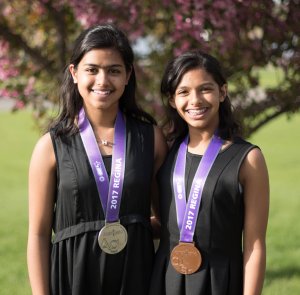
HWDSB Science Fair Projects Gather More Accolades
Some of HWDSB’s brightest were rewarded for their innovative science research projects this past week at the Canada-Wide Science Fair (CWSF).
The science fair was held at the University of Regina, and invited Grade 7 to 12 student finalists from across Canada who generated solutions to local, regional and global concerns with their science project. This year’s competition highlighted issues regarding energy, environment, health, information, resources and discovery, and offered nearly $1 million in cash awards and scholarships.
In all, 16 local students were chosen at The Bay Area Science and Engineering Fair (BASEF) to represent Team BASEF at the national competition. From Team BASEF, two HWDSB students received awards for their in-depth research and inventive science projects.
Here are the winning HWDSB students and their outstanding projects:
Anika Gupta, Westdale Secondary School, Grade 9
Project: ‘A Novel Approach to Protect Dopamine Neurons Using a Peptide and Trophic Factor’
The neuroprotective properties of two novel agents, MANF/CDNF neurotrophic factor, and TP5 synthetic peptide have been tested in a worm model of Parkinson’s disease (PD). The effects of these two factors on dopaminergic neurons were examined by a combination of mutant analysis and transgenic studies. Both agents suppressed age-dependent as well as oxidative stress-induced neurodegeneration, demonstrating their potentials as effective drugs for PD treatments.
Award:
Excellence Award (Intermediate), Silver Medal
Western University Scholarship Silver Medallist, $2,000 Entrance Scholarship
Neha Gupta, Sir William Osler Elementary School, Grade 7
Project: ‘Development of a Portable System for Detection of Bacteria Using DNA Biomarkers’
The goal of this project is to develop a portable device to detect bacteria using DNA biomarkers, a DNA detector, and a fluorescent light sensor. Towards this, several biomarkers were identified, a subset was validated using known bacteria specimen, and externally accessible body fluid samples were tested for the presence of bacteria. This device can accelerate identification of pathogens in a sensitive and affordable manner.
Award:
Excellence Award (Junior), Bronze Medal
Western University Scholarship Bronze Medallist, $1,000 Entrance Scholarship
Updated on Wednesday, May 31, 2017.


